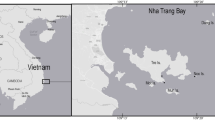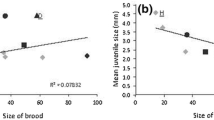Abstract
The biochemical and energetic composition of body components of ten species of bathyal echinoids, and an asteroid, a holothuroid and a stalked crinoid were determined from individuals sampled from a variety of deep-water sites near the Bahamas (north Caribbean Sea) in October 1988. When compared with other studies of echinoderms, no geographic- or depth-related differences in biochemical or energetic composition were found. Body-wall tissues were composed primarily of skeletal material (mineral ash), but were comparatively high in organic material in the echinothuriid echinoids, and the asteroid and holothuroid. Gut tissues and pyloric cecae had high levels of lipid and protein, indicating their potential role in nutrient storage. Body-wall tissues were generally low in energy, but were highest in the echinoidsAraeosoma belli (7.7 kJ g−1 dry wt) andSperosoma antillense (8.0 kJ g−1 dry wt), the asteroidOphidiaster alexandri (8.9 kJ g−1 dry wt), and the holothuroidEostichopus regalis (13.1 kJ g−1 dry wt). Energy levels of gut and pyloric cecal tissues were two to three times higher than those of body-wall tissues. Total somatic tissue energy values varied greatly among species, ranging from 1.5 kJ in the echinoidAspidodiadema jacobyi to 142.1 kJ inE. regalis. As the bathyal echinoderms examined in this study occur in great abundance, they represent a significant reservoir of organic and inorganic materials and energy in deep-water benthic systems.
Similar content being viewed by others
Literature cited
Brody, S. (1945). Bioenergetics and growth. Reinhold, New York
Dubois, M., Gilles, K. A., Hamilton, J. K., Rebers, P. A., Smith, R. (1956). Colorimetric method of determination of sugars and related substances. Analyt. Chem. 28:350–356
Freeman, N. K., Lindgren, K. T., Ng, N. Y., Nichols, A. V. (1957). Infrared spectra of some lipoproteins and related lipids. J. biol. Chem. 203:293–304
Giese, A. C. (1966). On the biochemical constitution of some echinoderms. In: Boolootian, R. A. (ed.) Physiology of Echinodermata. Wiley, New York, p. 757–796
Giese, A. C. (1976). Physiology of the echinoderm body wall. Thalassia jugosl. 12:153–163
Khripounoff, A., Sibuet, M. (1980). La nutrition d'échinodermes abyssaux. I. Alimentation des holothuries. Mar. Biol. 60:17–26
Klinger, T. S., Watts, S. A., Forcucci, D. (1988). Effect of short-term feeding and starvation on storage and synthetic capacities of gut tissues ofLytechinus variegatus (Lamarck) (Echinodermata: Echinoidea). J. exp. mar. Biol. Ecol. 117:187–195
Krishnan, S. (1968). Histochemical studies on reproductive and nutritional cycles of the holothurian,Holothuria scabra. Mar. Biol. 2:54–64
Lawrence, J. M. (1973). Level, content and caloric equivalents of the lipid, carbohydrate, and protein in the body components ofLuidia clathrata (Echinodermata: Asteroidea). J. exp. mar. Biol. Ecol. 11: 263–274
Lawrence, J. M. (1985). The energetic echinoderm. In: Keegan, B. F., O'Connor, B. D. S. (eds.) Echinodermata. A. A. Balkema, Rotterdam, p. 47–68
Lawrence, J. M., Guille, A. (1982). Organic composition of tropical, polar, and temperate-water echinoderms. Comp. Biochem. Physiol. 72B: 283–287
Lawrence, J. M., Kafri, J. (1979). Numbers, biomass, and caloric content of the echinoderm fauna of the rocky shores of Barbados. Mar. Biol. 52: 87–91
Lowry, O., Rosebrough, N. J., Farr, A. L., Randall, R. J. (1951). Protein measurement with the Folin phenol reagent. J. biol. Chem. 193: 265–275
Magniez, P. (1983). Reproductive cycle of the brooding echinoidAbatus cordatus (Echinodermata) in Kerguelen (Antarctic Ocean): changes in the organ indices, biochemical composition, and caloric content of the gonads. Mar. Biol. 74: 55–64
McClintock, J. B. (1989a). Energetic composition, reproductive output, and resource allocation of antarctic asteroids. Polar Biol. 9: 147–153
McClintock, J. B. (1989b). The biochemical and energetic composition of somatic tissues during growth in the sea star,Pycnopodia helianthoides (Echinodermata: Asteroidea). Comp. Biochem. Physiol. 931: 695–698
McClintock, J. B., Pearse, J. S. (1987a). Biochemical composition of antarctic echinoderms. Comp. Biochem. Physiol. 6B: 683–687
McClintock, J. B., Pearse, J. S. (1987b) Reproductive biology of the common antarctic crinoidPromachocrinus kerguelensis (Echinodermata: Crinoidea). Mar. Biol. 96: 375–383
McClintock, J. B., Pearse, J. S., Bosch, I. (1988). Population structure and energetics of the shallow-water antarctic sea starOdontaster validus in contrasting habitats. Mar. Biol. 99: 235–246
Menzies, R. J., George, R. Y., Rowe G. T. (1973). Abyssal environments and ecology of the world oceans. Wiley-Interscience, New York
Paine, R. T. (1971). The measurement and application of the calorie to ecological problems. A. Rev. Ecol. Syst. 2: 145–164
Prim, P., Lawrence, J. M., Turner, R. L. (1976). Protein, carbohydrate, and lipid levels of the adult body wall ofActinopyga agassizi, Synaptula hydriformis, andPentacta pygmea (Echinodermata: Holothuroidea). Comp. Biochem. Physiol. 55B: 307–309
Rowe, G. T., Staresinic, N. (1979). Sources of organic matter to the deep-sea benthos. Ambio 6: 19–25
Saito, N., Watts, S. A. (1989). Activities of hexokinase, phosphofructokinase, and pyruvate kinase in the body wall, pyloric caeca and tube feet ofAsterias vulgaris: evidence of body wall as a major source of glycolytic activity. Comp. Biochem. Physiol. 94B: 263–267
Sanders, H. L., Hessler, R. R., Hampson, G. R. (1965). An introduction to the study of deep-sea benthic faunal assemblages along the Gay Head-Bermuda transect. Deep-Sea Res. 12: 845–867
Sibuet, M., Lawrence, J. M. (1981). Organic content and biomass of abyssal holothuroids (Echinodermata) from the Bay of Biscay. Mar. Biol. 65: 143–147
Wacasey, J. W., Atkinson, E. G. (1987). Energy values of marine benthic invertebrates from the Canadian Arctic. Mar. Ecol. Prog. Ser. 39: 243–250
Walker, M., Tyler, P. A., Billett, D. S. M. (1987a). Organic and calorific content of the body tissues of deep-sea elasipodid holothurians in the northeast Atlantic Ocean. Mar. Biol. 96: 277–282
Walker, M., Tyler, P. A., Billett, D. S. M. (1987b). Biochemical and calorific content of deep-sea aspidochirotid holothurians from the northeast Atlantic Ocean. Comp. Biochem. Physiol. 88A: 549–551
Author information
Authors and Affiliations
Additional information
Communicated by J. M. Lawrence, Tampa
Rights and permissions
About this article
Cite this article
McClintock, J.B., Cameron, J.L. & Young, C.M. Biochemical and energetic composition of bathyal echinoids and an asteroid, holothuroid and crinoid from the Bahamas. Mar. Biol. 105, 175–183 (1990). https://doi.org/10.1007/BF01344284
Accepted:
Issue Date:
DOI: https://doi.org/10.1007/BF01344284




